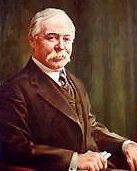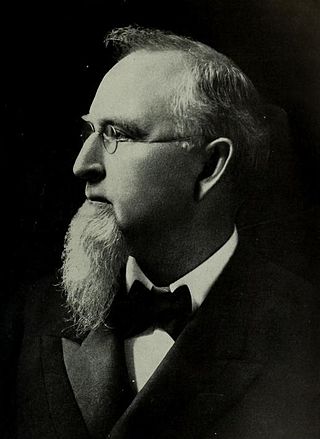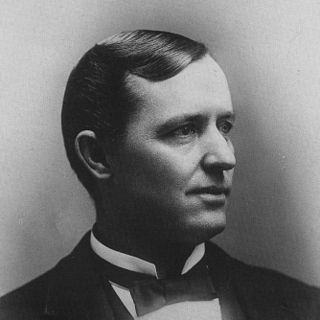
Montana is a state in the Mountain West subregion of the Western United States. It borders Idaho to the west, North Dakota and South Dakota to the east, Wyoming to the south, and the Canadian provinces of Alberta, British Columbia, and Saskatchewan to the north. It is the fourth-largest state by area, the eighth-least populous state, and the third-least densely populated state. Its capital is Helena, while the most populous city is Billings. The western half of the state contains numerous mountain ranges, while the eastern half is characterized by western prairie terrain and badlands, with smaller mountain ranges found throughout the state.

Helena is the capital city of the U.S. state of Montana and the seat of Lewis and Clark County.

Deer Lodge is a city in and the county seat of Powell County, Montana, United States. The population was 2,938 at the 2020 census.

Marcus Daly was an Irish-born American businessman known as one of the four "Copper Kings" of Butte, Montana, United States.

Butte is a consolidated city-county and the county seat of Silver Bow County, Montana, United States. In 1977, the city and county governments consolidated to form the sole entity of Butte-Silver Bow. The city covers 718 square miles (1,860 km2), and, according to the 2020 census, has a population of 34,494, making it Montana's fifth-largest city. It is served by Bert Mooney Airport with airport code BTM.

The Clark Fork, or the Clark Fork of the Columbia River, is a river in the U.S. states of Montana and Idaho, approximately 310 miles (500 km) long. The largest river by volume in Montana, it drains an extensive region of the Rocky Mountains in western Montana and northern Idaho in the watershed of the Columbia River. The river flows northwest through a long valley at the base of the Cabinet Mountains and empties into Lake Pend Oreille in the Idaho Panhandle. The Pend Oreille River in Idaho, Washington, and British Columbia, Canada which drains the lake to the Columbia in Washington, is sometimes included as part of the Clark Fork, giving it a total length of 479 miles (771 km), with a drainage area of 25,820 square miles (66,900 km2). In its upper 20 miles (32 km) in Montana near Butte, it is known as Silver Bow Creek. Interstate 90 follows much of the upper course of the river from Butte to Saint Regis. The highest point within the river's watershed is Mount Evans at 10,641 feet (3,243 m) in Deer Lodge County, Montana along the Continental Divide.
The Missoulian is a daily newspaper printed in Missoula, Montana, United States. The newspaper has been owned by Lee Enterprises since 1959. The Missoulian is the largest published newspaper in Western Montana, and is distributed throughout the city of Missoula, and most of Western Montana.
This is a broad outline history of the state of Montana in the United States.

James Edward Murray was an American politician and United States Senator from Montana, and a liberal leader of the Democratic Party. He served in the United States Senate from 1934 until 1961.

The Copper Kings were industrialists Marcus Daly, William A. Clark, James Andrew Murray and F. Augustus Heinze. They were known for the epic battles fought in Butte, Montana, and the surrounding region, during the Gilded Age, over control of the local copper mining industry, the fight that had ramifications for not only Montana, but the United States as a whole.

William Andrews Clark Sr. was an American entrepreneur, involved with mining, banking, and railroads, as well as a politician.

Thomas Henry Carter was an American politician, who served as territorial delegate, a United States representative, and a U.S. Senator from Montana. Carter was born in Junior Furnace, Ohio, on October 30, 1854. Born to an Irish immigrant family, he spent most of his childhood in on small farms in the Midwest. In 1882, he moved to Helena, Montana to begin his law career there. He entered then politics, and was elected Montana's territorial delegate in 1888. Following Montana's admission into the union as a state, Carter represented the state in U.S. House of Representatives. He ran for re-election in 1890, but was narrowly defeated by Democrat William W. Dixon in the general election.

Lee Mantle was an American businessman and politician from Montana. A Republican, he was most notable for his service as a United States Senator from 1895 to 1899.

Samuel Thomas Hauser was an American industrialist and banker who was active in the development of Montana Territory. He made his first fortune in silver mines and railroads, but he lost everything in the Panic of 1893. He restored his fortune by building hydroelectric dams, only to lose it all again after his Hauser Dam burst. In addition to his many business interests, he was appointed the 7th Governor of the Montana Territory, serving from 1885 to 1887.

William Francis Dunne was an American Marxist political activist, newspaper editor and trade unionist. He is best remembered as the editor of the radical Butte Bulletin around the turn of the 1920s and as an editor of the daily newspaper of the Communist Party USA from the middle-1920s through the 1930s. Dunne was founding member of the Communist Labor Party of America, but was removed from the national leadership of the party in 1934 and expelled in 1946 on charges of factionalism.

The following works deal with the cultural, political, economic, military, biographical and geologic history of pre-territorial Montana, Montana Territory and the State of Montana.
Since its incorporation in 1885, Missoula, Montana has been one of the primary media markets in the state of Montana, beginning with the weekly newspaper the Missoula and Cedar Creek Pioneer. The Missoula single-broadcast over-air television media market has been the largest in Montana since 2002. Though Billings is the largest city in Montana, Missoula's single-broadcast over-air television media market includes Missoula, Ravalli, Granite, Mineral, Lake, Flathead, and Sanders and serves over 113,000 television homes (2011). Missoula is also home to the state's third largest daily newspaper, the Missoulian, and the state's largest alternative weekly, the Missoula Independent.
The Boston and Montana Consolidated Copper and Silver Mining Company was a mining, smelting, and refining company which operated primarily in the state of Montana in the United States. It was established in 1887 and merged with the Amalgamated Copper Company in 1901. The Amalgamated Copper Company changed its name to Anaconda Copper in 1910, and became one of America's largest corporations. Historian Michael P. Malone has written, "Well financed and well managed, the Boston and Montana came to rank among the world's greatest copper companies."

Butte is a city in southwestern Montana established as a mining camp in the 1860s in the northern Rocky Mountains straddling the Continental Divide. Butte became a hotbed for silver and gold mining in its early stages, and grew exponentially upon the advent of electricity in the late-nineteenth century due to the land's large natural stores of copper. In 1888 alone, mining operations in Butte had generated an output of $23 million. The arrival of several magnates in the area around this time, later known as the "Copper Kings," marked the beginning of Butte's establishment as a boomtown.
The Montana State League was a minor league baseball league that played various seasons between 1892 and 1925 as an Independent league. As the name implies, the Montana State League consisted of teams based in exclusively in Montana, with the exception of the 1909 season when Idaho and Utah were represented. The Montana State League played just the three documented minor league seasons and had several other seasons of professional play without official records.

















